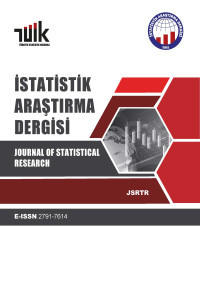Hizmet Sektöründe Mali Başarısızlığın Modellenmesi
Ekonomik faliyetlerdeki değişimlerin takip edilmesi ve mali başarısızlığı tetikleyen faktörlerin saptanması, hem ülke ekonomisini hem de firmaların şahsi durumlarını değerlendirmesi açısından önemlidir. Bu çalışmada, Türkiye’de hizmetler sektöründe bulunan firmaların mali başarı olasılıklarının hesaplanması ve bu başarının yıllar içinde değişiminin gözlenmesi amaçlanmıştır. Bu amaçla, İstanbul Menkul Kıymetler Borsası’ndan alınan bilançolar incelenmiş, zaman içinde tekrarlı ölçümlerden oluşan bu karmaşık yapıdaki verilerin analizi için çok seviyeli ‘Marjinalleştirilmiş Otoregresif Rastgele Etki Modelleri’ (MTREM) kullanılmıştır. Bu modellerle, her şirketin mali başarı olasılıklarını hesaplamak, farklı alt gruplardaki şirketlerin başarılarını karşılaştırmak ve zaman içindeki değişimleri gözlemlemek mümkündür. Karşılaştırma amacıyla, sık kullanılan tek seviyeli lojistik regresyon modelleri de aynı veriye uygulanmıştır. Doğru sınıflandırma oranlarına bakıldığında, MTREM’in lojistik modellere üstünlüğü gözlenmiştir.
Anahtar Kelimeler:
Hiyerarşik istatistiki modeller, Panel veri, Şirket rasyoları
Modeling Financial Failure in Service Sector
Observing the economical changes and determining the factors related to financial failure are important for both the economical development of the country and for the self - evaluation of individual firms. In this study, the calculation of the financial success pobabilities for the Turkish firms in service sector and the investigation of temporal change in these probabilities are aimed. With this purpose in mind, financial stataments that are collected from İstanbul Stock Exchange are investigated, and multilevel statistical models are used for analysing this complex structured data which consists of repeated measurements in time. Specifically, Marginalized Transition Random Effects Models (MTREM) are fitted. By these models, it is possible to calculate financial success probabilities for each company, to compare success of companies in different subgroups, and to observe the changes in time. With a purpose of comparison, popular single level logistic regression models are fitted as well. In terms of the true classification rates, it is observed that MTREM is superior to logistic regression models.
___
- Aktaş, R., 1997. Mali başarısızlık (İşletme Riski) tahmin modelleri, 2. baskı. Türkiye İş Bankası Kültür Yayınları, Ankara.
- Altman, E.I., 1968. Financial ratios, discriminant analysis and the prediction of corporate bankruptcy. The Journal of Finance, c.XXIII, 4, 589-609.
- Brooks, S.P., 1998. Markov chain Monte Carlo method and its application. The Statistician, 47, 69-100.
- De Andres, J., Landajo M., Lorca P., 2005. Forecasting business profitability by using classification techniques: A comparative analysis based on Spanish case. European Journal of Operational Research, 167, 518-542.
- Gelman, A. J., Carlin, B., Stern H. S., Rubin D. B., 2003. Bayesian data analysis, 2nd edition. Chapman & Hall, London.
- Geman, S., Geman, D., 1984. Stochastic relaxation, Gibbs distributions, and the Bayesian restoration of images. IEEE Transactions on Pattern Analysis and Machine Intelligence, 6, 721-741.
- İbrahim, J. G., Chen M.-H., Lipsitz S. R., 2002. Bayesian methods for generalized linear models with covariates missing at random. The Canadian Journal of Statistics- La revue canadienne de statistique, 30, 55–78.
- İlk, O., 2004. Exploratory multivariate longitudinal data analysis and models for multivariate longitudinal binary data, (Basılmamı? Doktora Tezi). Iowa State University, Ames, United States of America (Ingilizce).
- İlk, O., Daniels, M., 2007. Marginalized transition random effects models for multivariate longitudinal binary data. The Canadian Journal of Statistics-La revue canadienne de statistique, 35, 105-123.
- Liao, J., Gartner, W.B., 2006. The effects of pre-venture plan timing and perceived environmental uncertainty on the persistence of emerging firms, small business economics, 27, 23–40.
- Mittal, V., Anderson, E.W., Sayrak, A., Tadikamalla, P., 2005. Dual emphasis and the long-term financial impact of customer satisfaction. Marketing Science, 24,4, 544–555.
- Neal, R.M., 1996. Bayesian learning for neural networks. Springer-Verlag, New York.
- Neter, J., Kutner, M.H., Nachtseim, C.J., and Wasserman, W., 1996. Applied linear statistical models, 4th edition. Irwin, Chicago.
- Ohlson, J.A., 1980. Financial ratios and the probabilistic prediction of bankruptcy. Journal of Accounting Research, 109-111.
- R, 2006. http://www.r-project.org/, Erişim tarihi: 1, Haziran, 2006
- Yao, S., Jiang, C., Feng, G., Willenbockel, D., 2007. WTO challenges and efficiency of Chinese banks. Applied Economics, 39, 629–643.
- ISSN: 1303-6319
- Başlangıç: 2002
- Yayıncı: TÜİK
Sayıdaki Diğer Makaleler
Güçlü İkili Kovaryans Tahmincisinin Performans Değerlendirmesi
Özlem GÜRÜNLÜ ALMA, Serdar KURT, Aybars UĞUR
Kardeş Cinsiyet Bileşiminin Eğitimsel Erişimlere Etkisi
Yapısal Bağımlılık Altında Karmaşık MAPK Yolunun Bayesci Tahmini
Hizmet Sektöründe Mali Başarısızlığın Modellenmesi
Özlem İLK, Murat ÇİNKO, Deniz AKINÇ, Didem PEKKURNAZ
Mevsimsel Düzeltme için ARIMA Model Tabanlı Yaklaşım
Orman Yönetiminde Boolean Yaklaşımı
Açıklayıcı ve Doğrulayıcı Faktör Analizlerinin Karşılaştırılması: Bir Uygulama
